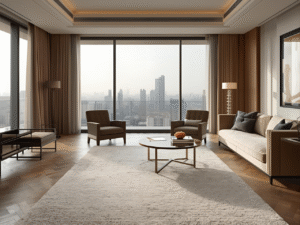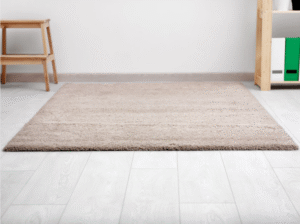When it comes to creating a cozy and stylish bedroom, the right floor covering can make all the difference. Yet many homeowners find themselves confused about the various options available. Should you choose a mat, rug, or carpet? What’s the difference between them? A bedroom mat serves as more than just a decorative piece—it’s a functional addition that provides comfort, warmth, and style to your personal sanctuary.
Understanding what a bedroom mat is and how it differs from other floor coverings will help you make an informed decision for your space. From providing that soft landing for your feet in the morning to adding a pop of color that ties your room together, bedroom mats offer versatility that larger floor coverings simply cannot match.
What is a Bedroom Mat?
A bedroom mat is a small to medium-sized floor covering designed specifically for use in bedrooms. Unlike larger rugs or wall-to-wall carpets, bedroom mats are typically compact, measuring anywhere from 2×3 feet to 4×6 feet. They’re strategically placed in high-traffic areas of the bedroom, such as beside the bed, under the bed, or at the bedroom entrance.
These mats are commonly made from materials like cotton, microfiber, jute, or feature rubber-backed construction for stability. The choice of material often depends on the intended function—whether you prioritize comfort, durability, or easy maintenance. Cotton and microfiber options offer softness and washability, while jute provides a natural, textured appearance that complements various décor styles.
Key Functions of a Bedroom Mat
Bedroom mats serve multiple practical purposes that enhance your daily comfort and room aesthetics. The primary function is providing a soft, warm surface for your feet when you step out of bed each morning. This is especially valuable during colder months when hardwood, tile, or laminate floors can feel uncomfortably cold.
Beyond comfort, bedroom mats add insulation between your feet and the floor, helping to maintain warmth in the room. They also help define different spaces within your bedroom, creating visual boundaries that make the room feel more organized and intentional.
From a practical standpoint, these mats protect your flooring from dust, debris, and general wear that comes from daily foot traffic. They’re particularly useful in preventing scratches on hardwood floors and reducing the accumulation of dirt in high-traffic areas.
Types of Bedroom Mats
Bedside Mats are the most common type, placed on one or both sides of the bed. These are typically smaller, measuring around 2×3 feet, and focus on providing comfort for your first steps each morning.
Under-bed Mats are larger floor coverings that sit partially or fully under the bed frame. These create a cohesive look and can make smaller bedrooms appear more spacious by creating a unified floor area.
Door Mats for Bedroom Entrance serve a dual purpose of catching dirt and debris while adding a welcoming touch to your private space. These are usually more durable and easier to clean than decorative options.
Anti-slip or Memory Foam Mats prioritize safety and comfort. Memory foam options provide extra cushioning for those who prefer a softer surface, while anti-slip varieties ensure stability on smooth floors.
Bedroom Mats vs. Rugs vs. Carpets
Understanding the differences between these floor covering options helps you make the right choice for your space and budget.
Bedroom mats are typically the smallest option, ranging from 2×3 to 4×6 feet. They’re designed for specific placement and easy maintenance, with most being machine-washable. Their primary purpose is functional comfort with decorative appeal.
Bedside rugs are generally larger, ranging from 5×7 to 8×10 feet, and are meant to anchor furniture arrangements. They’re often more decorative and made from premium materials, but they also require more maintenance and professional cleaning.
Carpets refer to wall-to-wall floor covering that’s typically installed permanently. They provide complete floor coverage but represent a significant investment and long-term commitment.
For smaller bedrooms or rental properties, bedroom mats offer the perfect balance of function and style without the commitment of larger pieces.
How to Choose the Right Bedroom Mat
Selecting the ideal bedroom mat depends on several key factors. First, consider the size of your space and where you plan to place the mat. Measure the area to ensure proper proportion—a mat that’s too small will look lost, while one that’s too large may overwhelm the space.
Color and pattern should complement your existing bedding, curtains, and overall room aesthetic. Neutral tones offer versatility and longevity, while bold colors or patterns can serve as accent pieces that add personality to your room.
Thickness and texture matter for both comfort and practicality. Thicker mats provide more cushioning but may be harder to clean, while thinner options are easier to maintain but offer less comfort.
Look for practical features like non-slip backing to prevent sliding, and machine-washable materials for easy care. These features become especially important in bedrooms where safety and hygiene are priorities.
Styling Tips for Bedroom Mats
Coordinate your bedroom mat with existing textiles like bedding, curtains, and throw pillows to create a cohesive look. This doesn’t mean everything must match perfectly—complementary colors and textures often create more visual interest than exact matches.
Consider layering smaller mats over larger rugs for added texture and warmth. This technique works particularly well in larger bedrooms where you want to create distinct zones or add extra comfort in specific areas.
Use bold colors or patterns strategically as accent pieces. A vibrant bedroom mat can serve as the focal point that ties together more neutral elements in your room design.
Care and Maintenance
Proper care extends the life of your bedroom mat and maintains hygiene in your personal space. Most cotton and microfiber mats are machine-washable, making them easy to clean regularly. Wash them every few weeks or as needed, depending on foot traffic and personal preference.
For mats that cannot be machine-washed, regular vacuuming and spot cleaning with appropriate cleaners will help maintain their appearance. Rotate your mats periodically to ensure even wear, especially in high-traffic areas.
Replace bedroom mats when they show significant wear, lose their shape, or develop odors that cleaning cannot eliminate. Generally, quality mats should last 1-3 years with proper care, depending on usage and material quality.
Frequently Asked Questions
Can I use a regular doormat as a bedroom mat?
While possible, doormats are typically designed for durability rather than comfort. They may be too rough or thick for bedroom use, and their designs often don’t complement bedroom aesthetics.
Are bedroom mats washable?
Most bedroom mats made from cotton, microfiber, or synthetic materials are machine-washable. Always check the care label for specific instructions, as some materials or rubber backing may require special care.
What size mat is best for a small bedroom?
For small bedrooms, stick to mats between 2×3 and 3×5 feet. Avoid oversized options that can make the space feel cramped. Consider placing one mat on the side of the bed you use most frequently rather than mats on both sides.
Transform Your Bedroom with the Perfect Mat
A bedroom mat is more than just a functional floor covering—it’s an opportunity to enhance your daily comfort while adding style to your personal space. Whether you choose a simple cotton mat for easy maintenance or a textured jute option for natural appeal, the right bedroom mat can transform your morning routine and complement your décor.
The key is selecting a mat that balances your practical needs with your aesthetic preferences. Consider your lifestyle, cleaning preferences, and design goals when making your choice.
Ready to elevate your bedroom’s comfort and style? Explore The Ambiente’s Premium Rug Collection, where traditional craftsmanship meets modern design. Our ethically sourced, handcrafted pieces are created by skilled artisans and offer the perfect blend of quality, style, and sustainability for your home.





